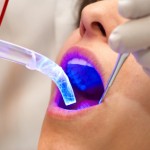
Dental caries is the most common preventable condition worldwide. Untreated dental caries can result in severe pain and infection and the cost of treatment is high. Caries detection traditionally uses a visual-tactile approach supplemented by radiographs. This approach typically detects caries at a level at which a restoration may be required so detection at an earlier stage allowing remineralisation and prevention would be an advantage. In the past two decades developments of fluorescence, transillumination, and electrical conductance devices may potentially aid the detection and diagnosis of caries at an early stage of decay.
The aim of this review was to assess the diagnostic test accuracy of fluorescence-based devices for the detection and diagnosis of enamel caries in children or adults.
Methods
Searches were conducted in the Medline, Embase, US National Institutes of Health Ongoing Trials Register (ClinicalTrials.gov) and the World Health Organization International Clinical Trials Registry Platform databases. diagnostic accuracy study designs that compared a fluorescence-based device with a reference standard were considered. Two reviewers independently extracted data with sensitivity and specificity and 95% confidence intervals (CIs) were reported for each study. Coupled forest plots and summary receiver operator characteristic (SROC) were used to display the data. Diagnostic accuracy was estimated using hierarchical summary receiver operating characteristic (HSROC) methods. Sensitivities were reported at fixed values of specificity (median 0.78, upper quartile 0.90).
Results
- 133 studies were included with 79 contributing data to the meta-analyses.
- The 79 studies provided 114 datasets evaluating 21,283 tooth surfaces for meta‐analysis.
- 78 of the datasets were in-vitro studies assessing extracted teeth in a laboratory setting.
- Selective participant recruitment, poorly defined diagnostic thresholds, and the generalisability of in vitro studies to clinical scenarios were a concern.
- Substantial heterogeneity in the results could not be explained by the different devices, dentition or other sources of heterogeneity investigated.
- The diagnostic odds ratio (DOR) was 14.12 (95%CI; 11.17 to 17.84)
- At a fixed median specificity of 0.78 estimated sensitivity was 0.70 (95%CI; 0.64 to 0.75)
- For a population with an enamel caries prevalence of 57% at an estimated sensitivity of 0.70 and specificity of 0.78 a hypothetical cohort of 1000 tooth sites or surfaces would result in 171 missed email lesions (false negatives) and 95 incorrect caries diagnoses (false positives) as shown in the table below.
| Diagnosis positive | Diagnosis negative | ||
| Fluoresence device positive | 399
(True positive) |
95
(False positive) |
494 |
| Fluoresence device negative | 171
(False negative) |
335
(True negative) |
506 |
| 570 | 430 | 1000 |
- The overall certainty of the evidence was rated as low.
Conclusions
The authors concluded: –
There is considerable variation in the performance of these fluorescence-based devices that could not be explained by the different wavelengths of the devices assessed, participant, or study characteristics. Blue and green fluorescence-based devices appeared to outperform red fluorescence-based devices, but this difference was not supported by the results of a formal statistical comparison. The evidence base was considerable, but we were only able to include 79 studies out of 133 in the meta-analysis as estimates of sensitivity or specificity values or both could not be extracted or derived. In terms of applicability, any future studies should be carried out in a clinical setting, where difficulties of caries assessment within the oral cavity include plaque, staining, and restorations. Other considerations include the potential of fluorescence devices to be used in combination with other technologies and comparative diagnostic accuracy studies.
Comments
This diagnostic test accuracy review of fluorescence-based devices and has been undertaken following standard Cochrane Diagnostic Test Accuracy (DTA) and is one of a suite of reviews using the same generic protocol. The review considered three main categories of fluorescence tests defined by wavelength, red- (wavelength greater than 655 nm), blue (wavelengths between 400 nm and 450 nm) and green (wavelength 370 nm) also including devices using quantitative light-induced fluorescence (QLF). However, statistically no difference in accuracy was seen according to the category of the device.
While a large number of datasets have been included in this review only one of the included studies was considered to be at low risk of bias for all the domains of the Quality Assessment of Diagnostic Accuracy Studies 2 (QUADAS-2). The reviewers also note that some studies purposefully investigated the most accurate threshold. In addition, a majority of the datasets (68%) were based on in-vitro studies which raises concerns relating to the clinical applicability of the findings. Future research should be conducted in a clinical setting, report data clearly and follow the STARD checklist.
Links
Primary Paper
Macey R, Walsh T, Riley P, Glenny AM, Worthington HV, Fee PA, Clarkson JE, Ricketts D. Fluorescence devices for the detection of dental caries. Cochrane Database Syst Rev. 2020 Dec 8;12:CD013811. doi: 10.1002/14651858.CD013811. PMID: 33319353.
Other references
Cochrane Oral Health Blog – How accurate are fluorescence devices for detecting and diagnosing early tooth decay?
Dental Elf – 14th Dec 2020
Dental Elf – 17th Oct 2013
